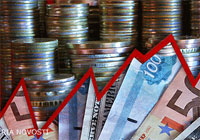Russia moving away from rate control to manage declining ruble

(Moscow News – themoscownews.com – Nathan Gray – January 28, 2014) The rapidly depreciating ruble recovered slightly on Tuesday, after recording a five-year low against the euro of 47.50 on Monday.
On Tuesday afternoon, the Central Bank indicated a rate of 47.37 against the euro, and 40.36 against the weighted currency basket of dollars and euros.
The ruble’s managed decline is part of a broader policy of inflation-targeting for long-term economic growth, Maria Pomelnikova, macroeconomic analyst at Raiffeisenbank, told The Moscow News.
“We’re moving away from control of the [exchange] rate with the fundamental goal of the Central Bank to instead establish control over inflation,” Pomelnikova said. “The faster we move away from rate control, the more effective management of the Central Bank’s exchange rate corridor will be, and the more effective anti-inflation policy will be.”
The inflation-targeting policy, which has grown stronger since Elvira Nabiullina took over as head of the Central Bank in June 2013, has come in for criticism from analysts and officials as well as praise over the past year, criticism especially over the bank’s refusal to cut interest rates to stimulate lending.
Presidential aide and former Economic Development Minister Andrei Belousov said in December that one of the main reasons why growth stimulus measures were not working out was the maintenance of high interest rates, which were “killing investment activity,” Prime News Agency reported.
Further, despite the efforts to control inflation, Russia missed its target for 2013. The State Statistics Service reported earlier this month that the rate for last year was 6.5 percent, overshooting even an increased estimate of 6.2 percent.
Independent of its role in the struggle with inflation, the policy’s main goal is to achieve a free-floating currency by 2015 in an effort to insulate the economy better from external shocks.
Meanwhile, Nabiullina herself said in an interview Monday night that the lower value of the ruble relative to the euro and the dollar was not a weakening, but a sign of the strengthening of the European and American currencies.
“It’s not that we have a weak ruble, but that the dollar and the euro have strengthened in relation to emerging market currencies,” Nabiullina said, RIA Novosti reported.
The Central Bank is not eliminating all interventions, but supporting the ruble beyond the upper end of the exchange-rate corridor before moving the corridor to accommodate the new rate. On Monday, for example, it spent more than $1 billion in supporting the ruble, moving the corridor three times. On Tuesday morning, it stood at between 33.65 and 40.65.
“On the higher edge of the corridor, speculative pressure was at its highest,” Raiffeisenbank’s Pomelnikova said. “Already [Tuesday] morning, we are trading at the level of 40.35 against the dual-currency basket, that is, we don’t see new concerns yet, but nevertheless, it is not excluded because the basket is moving quite fast.”
If speculative pressure resumed, she added, the basket could quickly reach the 40.65 end.
The speed of the decline notwithstanding, the reduction in value is more a correction of an “overvalued” currency, said Mark Adomanis, a management consultant at Booz Allen Hamilton in Washington.
“During the worst parts of the 2008-09 crisis, the Russian authorities spent a lot of money defending the value of the ruble and preventing a messy devaluation,” Adomanis told The Moscow News in an e-mail. “I think this opened their eyes to a certain extent and made them more aware of the risks that are associated with trying to control a currency’s value.”
Instead of taking as active a position as it did before of supporting the ruble, the government is allowing it to reach a more natural state, lower against the euro and the dollar.
There may be a broader intention to the policy, however: improving the status of Russian industry, which Nabiullina denied in her Monday night interview.
“From what I’ve read it sounds as if the authorities want to allow domestic industry to regain a more competitive position, and allowing the currency to weaken helps that,” Adomanis said.
Pomelnikova, however, doubts that domestic industry or the consumer sector will experience much of an effect, despite consumers’ taste for the imported goods that are becoming more expensive in ruble terms.
“First, this effect [on imports] shows itself with a slight lag,” she said. “Second, though of course not so strong a weakening, a serious enough weakening was witnessed last year, but still we did not see a strong effect on the consumer sector or on inflation.”
Judging from historical data and the lack of competitive Russian goods to replace imports, the demand for imported consumer goods is not likely to decline, despite the ruble’s lower value, she added.
